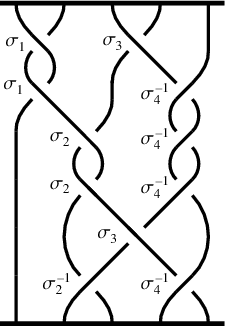Braid Isotopy
Consider a bunch of threads resting on a pinboard with two parallel rows of numbered pins on it. Each thread is pinned at its ends, and these ends cannot be moved, but its starting pin and its ending pin can be numbered differently and it can pass over or under any thread on its way there. Each pin tamps down one end of one thread (you can’t have multiple threads for a single pin).
Loosely, this situation corresponds to the mathematical idea of a braid. The trivial braid is one in which each thread goes straight from its numbered start pin to the end pin with the same number
The trivial 2-braid
The feature that makes braids more interesting than just some simple permutation mapping pins to pins is that they can cross over each other
1 crossing over 2
And the order of the crossing matters, because we can pick either thread to be “at the front”
2 crossing over 1
Braids of the same dimension n (called n-braids, and having the same number of pins in our analogy) can be composed. For example, here’s 1 crossing over 2, followed by “2” crossing over “1” (really it’s just a repositioned version of the same thread). This is the composition of the two nontrivial braids shown above. This also shows that “1 crossing over 2” is the inverse of “2 crossing over 1” because this new braid is isotopic to the trivial braid.
Composition (showing inversion)
One way to think about this isotopy in our physical threads-and-pins analogy is that we’re untangling braids, but we can’t lift or rearrange the ends of the threads (since they’re pinned to the board). We can only move threads around, not do weird nonphysical stuff like passing them through each other, and we’re definitely not allowed to get out the scissors and make quick work of this Gordian knot.
Here’s another braid that’s not isotopic to the trivial braid. Note how this follows the usual topological intuitions: we can stretch the threads out as long as we need, move them around, etc. but we can’t make cuts or glue pieces of threads together. So we’re stuck here without a way to untangle these threads.
Not isotopic to the trivial braid (cannot be untangled)
We’ve already seen at least hints of invertibility, closure, and identity, so it’s not going to be too much of a stretch for me to say that n-braids form a group \(B_n\).
There’s a surjective homomorphism from this group \(B_n\) to symmetric group \(S_n\), which is more or less a fancy way of saying that we have a way to map from n-braids to permutations. The way is pretty obvious: ignore the braids’ crossings and treat each thread as a mapping from a start pin to an end pin. The end pin numbers then form a permutation of the start pin numbers.
Braids can get much more complicated and interesting, and I don’t want you to think they’re boring just because of my drawing skills, so here’s a sneak peek at a more interesting 5-braid I grabbed from the internet:
Braids show up in a bunch of cool mathematical contexts that I don’t really know much about yet, but hopefully I’ll be able to weave them back into my writing in the future.
